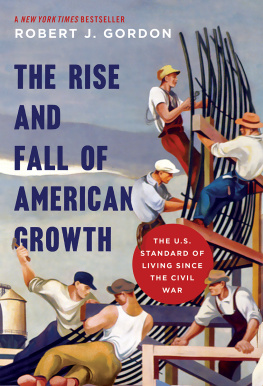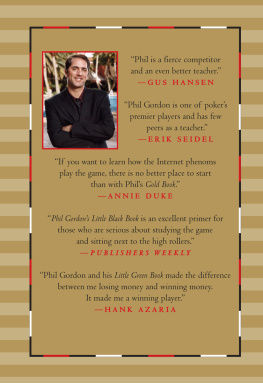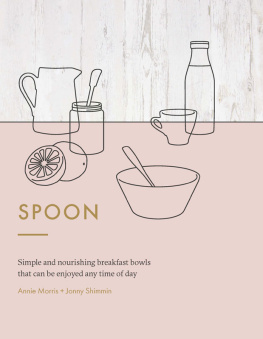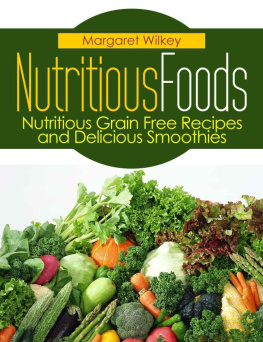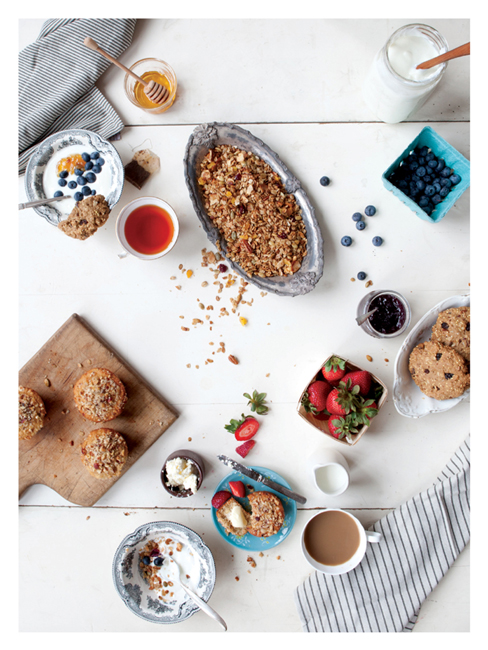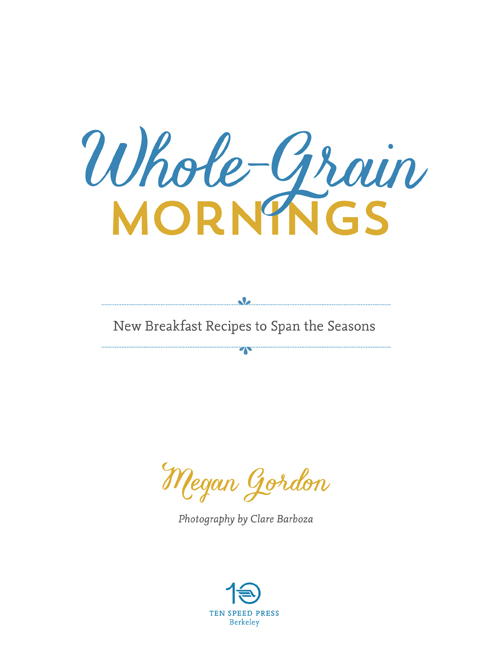Copyright 2013 by Megan Gordon
Photographs copyright 2013 by Clare Barboza
All rights reserved.
Published in the United States by Ten Speed Press, an imprint of the Crown Publishing Group, a division of Random House LLC, New York, a Penguin Random House Company.
www.crownpublishing.com
www.tenspeed.com
Ten Speed Press and the Ten Speed Press colophon are registered trademarks of Random House LLC.
All photographs by Clare Barboza with the exception of photographs which are by the author.
Library of Congress Cataloging-in-Publication Data
Gordon, Megan, 1979
Whole-grain mornings : new breakfast recipes to span the seasons / Megan Gordon.
pages cm
1. Breakfasts 2. Cooking (Cereals) 3. Grain. I. Title.
TX733.G66 2013
641.331dc23
2013015594
Hardcover ISBN: 978-1-60774-500-6
eBook ISBN: 978-1-60774-501-3
Printed in China
Food styling by Julie Hopper
v3.1
Contents
SPRING
coasting
SUMMER
settling in
FALL
gathering
WINTER
looking ahead
to MY MOM AND DAD,
with immense gratitude.
to SAM,
with my whole heart.
BEGINNINGS
I LEARNED TO COOK BY OBSERVATION AND TRIAL AND ERROR. As a girl, Id sit on the counter while my mom made dinner, feet dangling, snacking on Cheerios. On nights when wed have lasagna, she would reserve the broken shards of cooked noodles and Id form small ricotta roll-ups to busy myself. Id lay them out in neat rows, smitten with my own productivity. A few years later, I realized that a whole pan of lasagna was really just ricotta roll-ups on a larger scale: an act of repetition with noodles, sauce, and cheese. Soon I was making my own lasagna with very minimal assistancebeaming with pride the whole way through.
On Sunday evenings after putting my sisters and me to bed, my mom would write out what wed have for dinner that week as a way to organize her weekly trips to the grocery store. The sheet of yellow legal paper was always taped to the refrigerator, so when wed pass by the kitchen Monday morning, excitement grew as we thought about our favorite upcoming meal. Generally it was simple food that could be tackled after a long day of teaching, with small kids underfoot: spaghetti and meatballs, turkey potpie, tuna casserole, or baked chicken. Our meals never looked like those picture-perfect moments of dinner that wed see on television, with everyone digging in and sharing the details of their day. Instead, that hour was filled with three picky girls (or later, moody teenagers) and tired, overworked parents. But we always showed up nonetheless. In our house dinnertime was a statement that cooking and eating together at the same table was important. It was family.
Much like my mom, my grandmother is a gracious home cook. She makes a mean coconut cake with seven-minute frosting and her Jell-O salad is enthusiastically requested at holidays and reunions. My other grandmother, my dads mom, also tended toward simple recipes. From each of them, it wasnt noteworthy dishes or standout techniques that were passed down, so much as an appreciation and affinity for practice, repetition, and tradition. And so today I call myself a home cook, too. Theres a certain pride in the term that itself seems passed down by generations of women who learned by watching their mothers, reading cookbooks, paying attention, and pulling up a seat at the table. By dabbling and then diving in. So here we are.
ABOUT THIS BOOK
Ive always wanted to write a breakfast book. Its the meal we all start with, the meal that ushers us into the day. Even more, I wanted to write a book that reflects the way I do breakfast, acknowledging the fact that what we eat looks different on a cold, gray morning in February than it does on a sunny morning in June. A busy Wednesday brings about different breakfast options than does a leisurely Sunday. Sure, some of that has to do with the available produce. But a lot of it has to do with what were drawn to in those different months or what our bodies crave. So I decided to split this book into seasonal chapters and further divide each chapter, noting which recipes are best for busy weekdays, slow Sundays, or brunch. I hope you return to the book as the months pass, the seasons change, and friends and family trickle in and out to join you at the breakfast table throughout the year.
In addition to a seasonal breakfast book, I wanted to write a somewhat personal book, beginning in the San Francisco Bay Area and ending in Seattle. A book that tracks a particular season in my life, as much as the many breakfasts from that timethe story of a high school English teacher searching for a new school and landing in a bakery instead. The story of that accidental baker waking before sunrise to crimp pies and bake granola, finding herself looking at the work of a graphic designer one thousand miles away who might be able to help with branding the business.
That story is obviously mine. And that designer, Sam? Its now his, too. Sam worked for me for a little less than a year as I began my baking business, Marge. During this time, we met once face-to-face at a little caf in the Fremont neighborhood of Seattle, discussing websites and logos and drinking spicy chai. As was often the case, we fell into our usual digressions about folk music, films we liked, and good cheese. When our client relationship had come to an end, we threw ourselves into much longer phone calls, letters, travels across several states, and more than a few breakfasts together. Then, after too many seasons apart, Sam flew down to help me load a large U-Haul and make the long drive up the coast from San Francisco to a new home in Seattle. Today we share a bright blue craftsman house, a modest garden, and a very large comingled collection of books. While a good handful of the recipes in this cookbook were originally written in my shoebox kitchen in Northern California, many grew naturally from our new life here in Seattle. I think they might travel just as easily to your kitchen, too, regardless of where that may be.
ABOUT THE RECIPES
While this is technically a whole-grain cookbook, I dont consider it a health book or a definitive reference on whole-grain cooking. Within these pages, youll find cheese and butter and even a little bacon. But each recipe features whole grains as the star because theyre a nourishing way to start the morning, and Ive relied on them as such for years. I gravitate toward savory recipes more and more these days, so youll see breakfast ideas here that you might not normally think of as morning fare. My ultimate goal in writing these recipes is that youll stumble across something youre inspired to make in your own kitchen.
Big picture aside, there are a few things to know about the way Ive structured the chapters and recipes. First, each chapter will open with a brief introduction that includes a Seasonal Spotlight , featuring different fruits and vegetables that I cook with during those months and a few quick tips about selecting, storing, and preparing them. Then each recipe is slotted into a section: Busy Weekdays , Slow Sundays , or Brunch , based on the amount of time and effort it takes or Spreads and Toppings for accompaniments. Within most recipes, youll see a few lines I call Morning Notes , where I include additional information on ingredients or preparationgood things to know before getting started. At the end of each recipe, you may see a few lines I call Make Ahead , which will address how to maximize your time, and Make It Your Own , which will encourage you to adapt and experiment according to your tastes and preferences.





